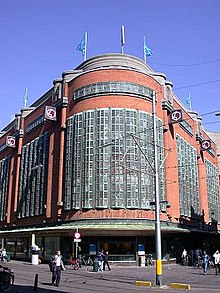De Bijenkorf
| De Bijenkorf
|
|
|---|---|
| legal form | |
| founding | 1870 |
| Seat | Amsterdam |
| Number of employees | 3000 |
| Branch | clothing |
| Website | https://www.debijenkorf.de/ |
De Bijenkorf (literally "the beehive ") is a chain of upscale department stores in the Netherlands . The largest branch is at Dam Square in Amsterdam . The chain is owned by the Weston family, which also owns Selfridges in the UK, Holt Renfrew in Canada and Brown Thomas in Ireland.
history

De Bijenkorf department store was founded in 1870 by Simon Philip Goudsmit (1845–1889). It started out as a haberdashery at 132 Nieuwendijk, one of the oldest streets in Amsterdam. Over time, the range expanded. After Goudsmit's death, his widow expanded the business with the help of her cousin Arthur Isaac and her son Alfred and bought neighboring buildings.
In 1909 these affiliated shops were replaced with a new building. In 1912 a temporary building was erected on the site of the demolition, and construction of a new shop building began next to it.

In 1926 a second shop was built in The Hague . It was designed by the architect Piet Kramer and is considered an example of the Amsterdam School of Architecture .
A third store in Rotterdam , designed by Willem Marinus Dudok , opened in 1930. Around 700,000 people came to the opening ceremony. In the bombing of Rotterdam in 1940 he was heavily damaged. The remaining intact part remained open until 1957, but was demolished in 1960 for the construction of the Rotterdam Metro . The new department store building was designed by the Hungarian-American architect Marcel Breuer .
During the occupation of the Netherlands by National Socialist Germany in World War II , the chain of department stores came into German possession as a Jewish company in the course of Aryanization and the persecution of Jews . Previously one was by the owners association of persons has been established and has been assigned the largest number of shares, but the German occupation forces denied their recognition. The German company Riensch & Held GmbH took over the Jewish business shares . Riensch & Held belonged to the Köster Group , and through this stake, Defense Economy Leader Herbert Tengelmann got a seat on the De Bijenkorf Supervisory Board in November 1943.
Of the 5,000 employees in May 1940, around 1,000 had Jewish roots, 737 of whom were murdered by the National Socialists. The owner family Isaac hid and Alfred Goudsmit managed to escape to the United States . After the war, the Dutch owners were able to get their property back.
In the later 20th century the company was owned by the Maxeda Group. In 2014 De Bijenkorf had seven branches across the country. The oldest and largest branches in Amsterdam, The Hague and Rotterdam have sales areas between 15,000 and 21,000 m². The smaller branches in Amstelveen , Eindhoven , Utrecht and Maastricht have sales areas between 7,500 and 10,000 m². The branches in Arnhem , Groningen , Enschede , Breda and Den Bosch closed between the end of 2014 and the beginning of 2015, as the parent group decided to focus on online trading due to the new premium service strategy. The building in Arnhem was taken over by Primark , which many Arnhem people saw as a step in drastically reducing the attractiveness of Arnhem's shopping center.
Web links
Individual evidence
- ^ Martin Dunford: The Rough Guide to The Netherlands . Penguin, 2010, ISBN 978-1-84836-882-8 , pp. 62-63 .
- ^ De Westons: de family eight Primark én de Bijenkorf. Retrieved August 28, 2018 .
- ↑ Maxeda verkoopt Bijenkorf aan Selfridges - Amsterdam - PAROOL. Accessed August 28, 2018 (nl-NL).
- ^ Harry den Hartog: Shanghai New Towns: Searching for community and identity in a sprawling metropolis . 010 Publishers, Rotterdam 2010, ISBN 978-90-6450-735-9 , pp. 114 ( preview in Google Book search).
- ^ Geschiedenis van De Bijenkorf . In: IsGeschiedenis . September 18, 2015 ( isgeschiedenis.nl [accessed on August 28, 2018]).
- ↑ Warenhuis de Bijenkorf, een geschiedenis long . In: Historiek . August 19, 2013 ( historiek.net [accessed August 28, 2018]).
- ↑ Cookies op AD.nl | AD.nl. Retrieved August 28, 2018 (Dutch).
- ↑ De oorlogsjaren
- ↑ Christoph Kreutzmüller, dealer and sales assistant: the financial center of Amsterdam and the major German banks (1918–1945). Steiner, Stuttgart 2005, ISBN 3-515-08639-0 .
- ↑ De oorlogsjaren
- ↑ Herstel na de Tweede Wereldoorlog
- ↑ De Bijenkorf heeft geen last van Hudson's Bay en blijft groeien. Retrieved August 28, 2018 .
- ↑ Focus op luxe loont: Meer winst en bezoekers voor Bijenkorf. Retrieved August 28, 2018 .
- ↑ Bijenkorf sluit distributiecentrum: 143 canteens in love baan. Retrieved August 28, 2018 .
Coordinates: 52 ° 22 ′ 23.5 " N , 4 ° 53 ′ 38" E


